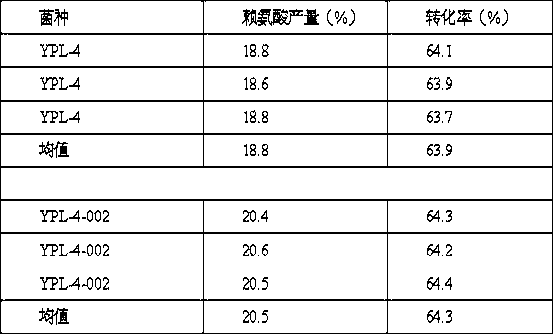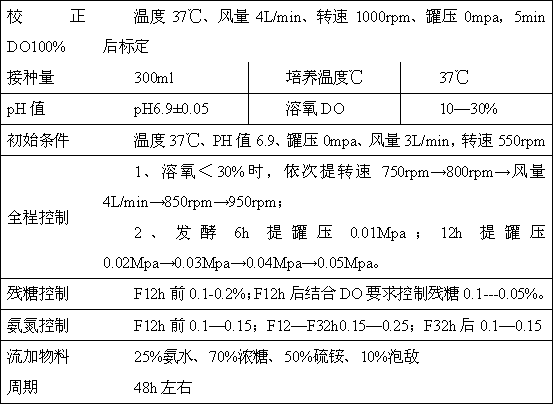Method for producing l-lysine by bacterial fermentation with altered ppc promoter
A lysine and promoter technology, applied in the field of amino acid fermentation, can solve the problems of unpredictable impact on L-lysine production, and achieve the effect of facilitating popularization and application and increasing production
- Summary
- Abstract
- Description
- Claims
- Application Information
AI Technical Summary
Problems solved by technology
Method used
Image
Examples
Embodiment 1
[0037] Example 1 contains point deletion NCgl1523 Construction of gene promoter transformation vector pK18-NCgl1523
[0038] According to the genome sequence of Corynebacterium glutamicum ATCC13032 published by NCBI, two pairs of amplification were synthesized NCgl1523 Gene promoter region fragment (the nucleotide sequence including the promoter and coding region is shown as the complementary sequence of SEQ ID NO: 5, or it can be accessed at https: / / www.ncbi.nlm.nih.gov / gene / *term =NCgl1523) primers to replace the wild type on the chromosome of strain YPL-4 by allelic replacement NCgl1523 One base is knocked out at position -1 of the promoter region of the gene (the nucleotide sequence including the promoter and the coding region is shown as the complementary sequence of SEQ ID NO: 6). Primers were designed as follows (synthesized by Shanghai Invitrogen Company):
[0039] P1': 5' CCGGAATTC GTGATGCGACGGCGGATGT 3' (EcoR I)
[0040] P2': 5' CTCAATGTGAAAGAGTGTTTAAAGTAGTTAA...
Embodiment 2
[0044] Example 2 contains point deletion NCgl1523 Construction of strains with gene promoters
[0045] The plasmid pK18-NCgl1523 obtained in Example 1 was electrotransformed into the lysine producing bacterium (Corynebacterium glutamicum) patent strain YPL-4 (namely YP97136) (for its construction method, please refer to WO2014121669A1; it was confirmed by sequencing that the strain on the chromosome wild-type NCgl1523 Genes and their promoters), the single colonies produced by culture were identified by primers P1' / M13F, and the strains that could amplify a band with a size of 1100bp were positive strains. The positive strains were cultured on a medium containing 12% sucrose, and the single colony produced by the culture was cultured on a medium containing kanamycin and a medium without kanamycin, respectively, and cultured on a medium without kanamycin The strains that grow on culture medium but do not grow on medium containing kanamycin are further identified by PCR usin...
Embodiment 3
[0049] Example 3 Contains point mutations NCgl1523 Gene transformation vector pK18-NCgl1523 A482V build
[0050] According to the genome sequence of Corynebacterium glutamicum ATCC13032 published by NCBI, two pairs of amplification were synthesized NCgl1523 Primers for fragments of the gene coding region (its nucleotide sequence is shown in the complementary sequence of SEQ ID NO: 1, and the encoded amino acid sequence is shown in SEQ ID NO: 3), so as to replace the YPL-4 chromosome by alleles wild type on NCgl1523 A482V point mutation is introduced into the coding region of the gene (the nucleotide sequence is shown in the complementary sequence of SEQ ID NO: 2, and the encoded amino acid sequence is shown in SEQ ID NO: 4). Primers were designed as follows (synthesized by Shanghai Invitrogen Company):
[0051] P1: 5' CGC GGATCC CCTGGGCTGGGCAAGAATC 3' (BamH I)
[0052] P2: 5' CCGAATTTCTTAACAACCTCCGACGCGGTG 3'
[0053] P3: 5' CACCGCGTCGGAGGTTGTTA AGAAATTCGG 3'
[00...
PUM
 Login to View More
Login to View More Abstract
Description
Claims
Application Information
 Login to View More
Login to View More - R&D Engineer
- R&D Manager
- IP Professional
- Industry Leading Data Capabilities
- Powerful AI technology
- Patent DNA Extraction
Browse by: Latest US Patents, China's latest patents, Technical Efficacy Thesaurus, Application Domain, Technology Topic, Popular Technical Reports.
© 2024 PatSnap. All rights reserved.Legal|Privacy policy|Modern Slavery Act Transparency Statement|Sitemap|About US| Contact US: help@patsnap.com









